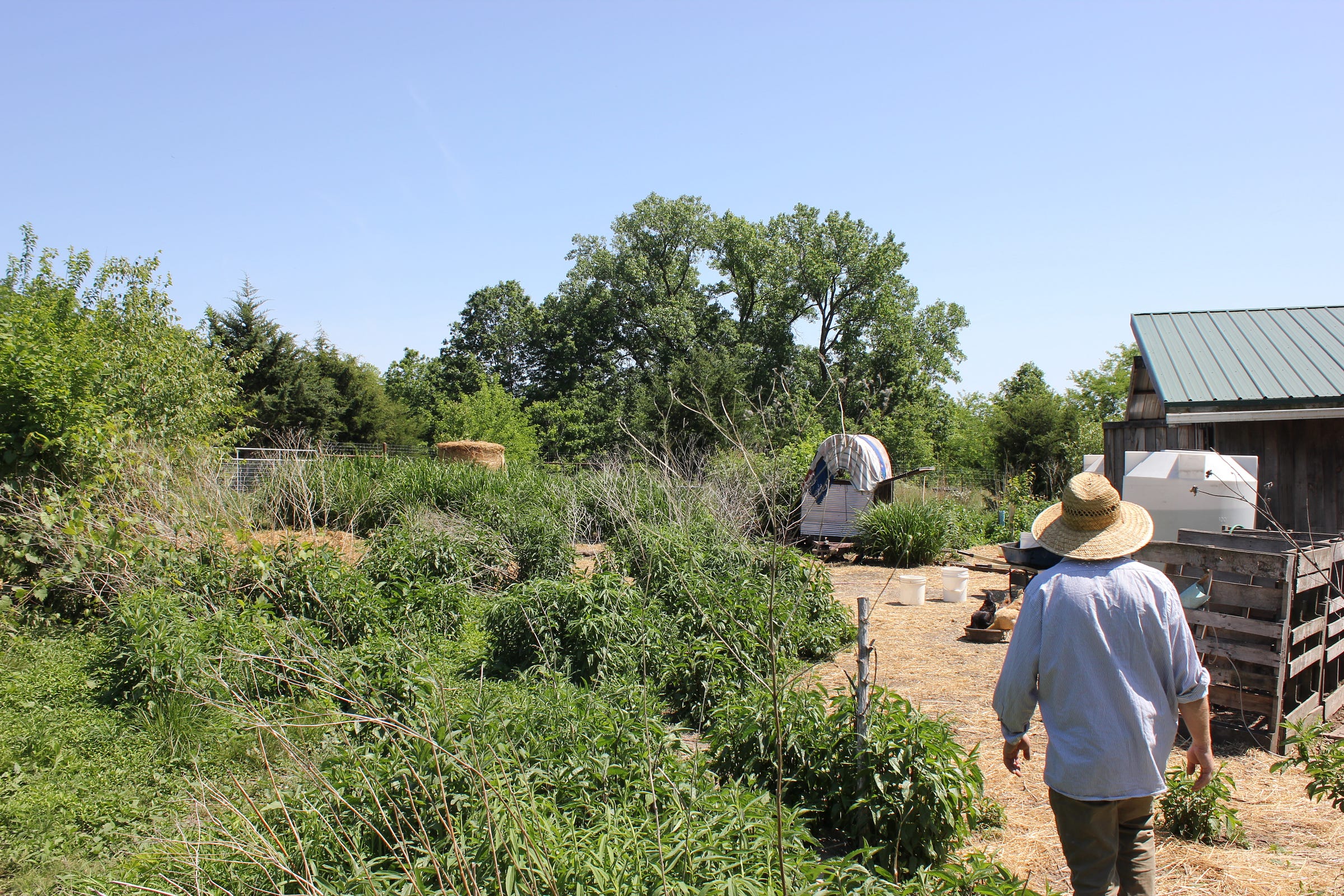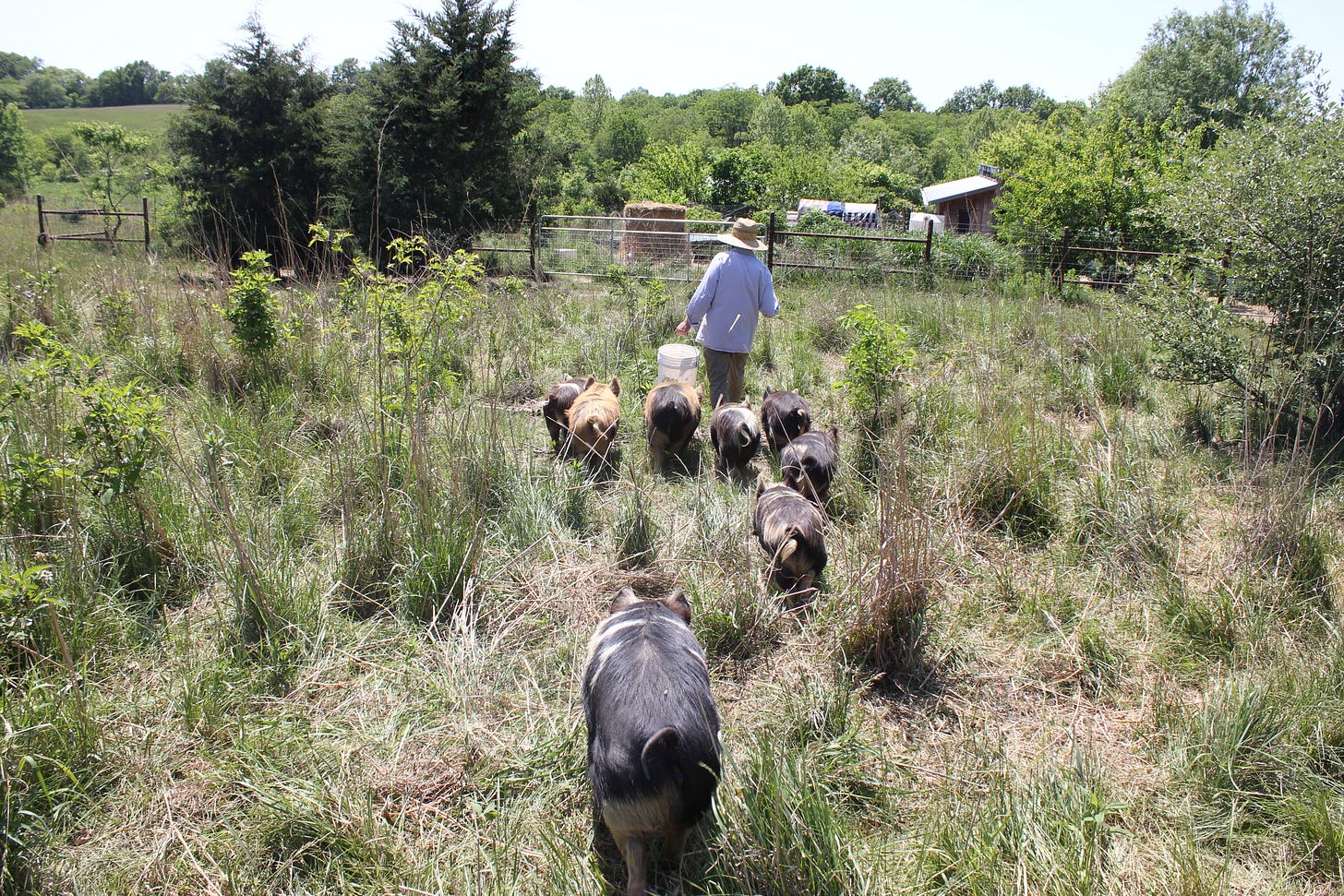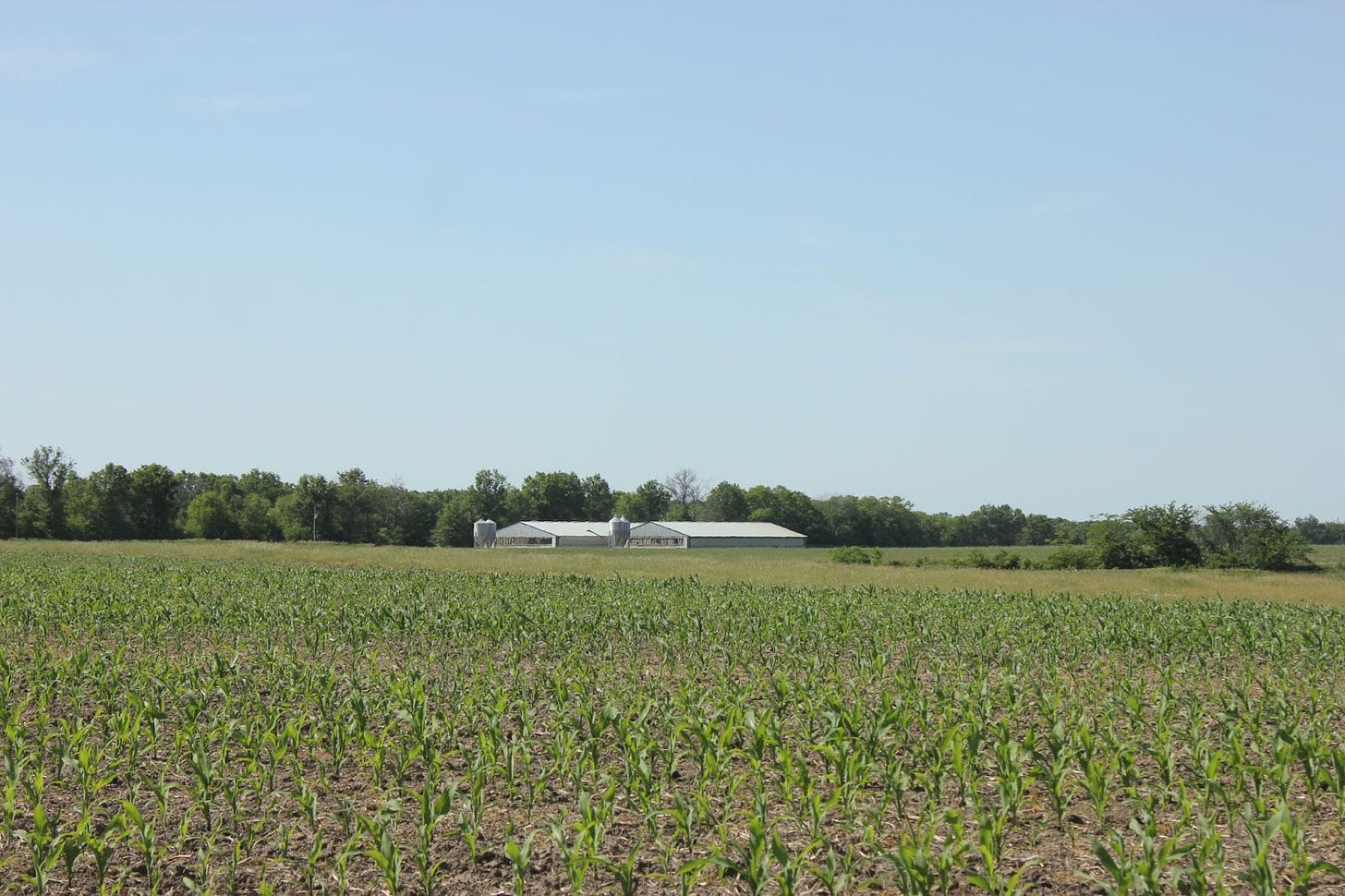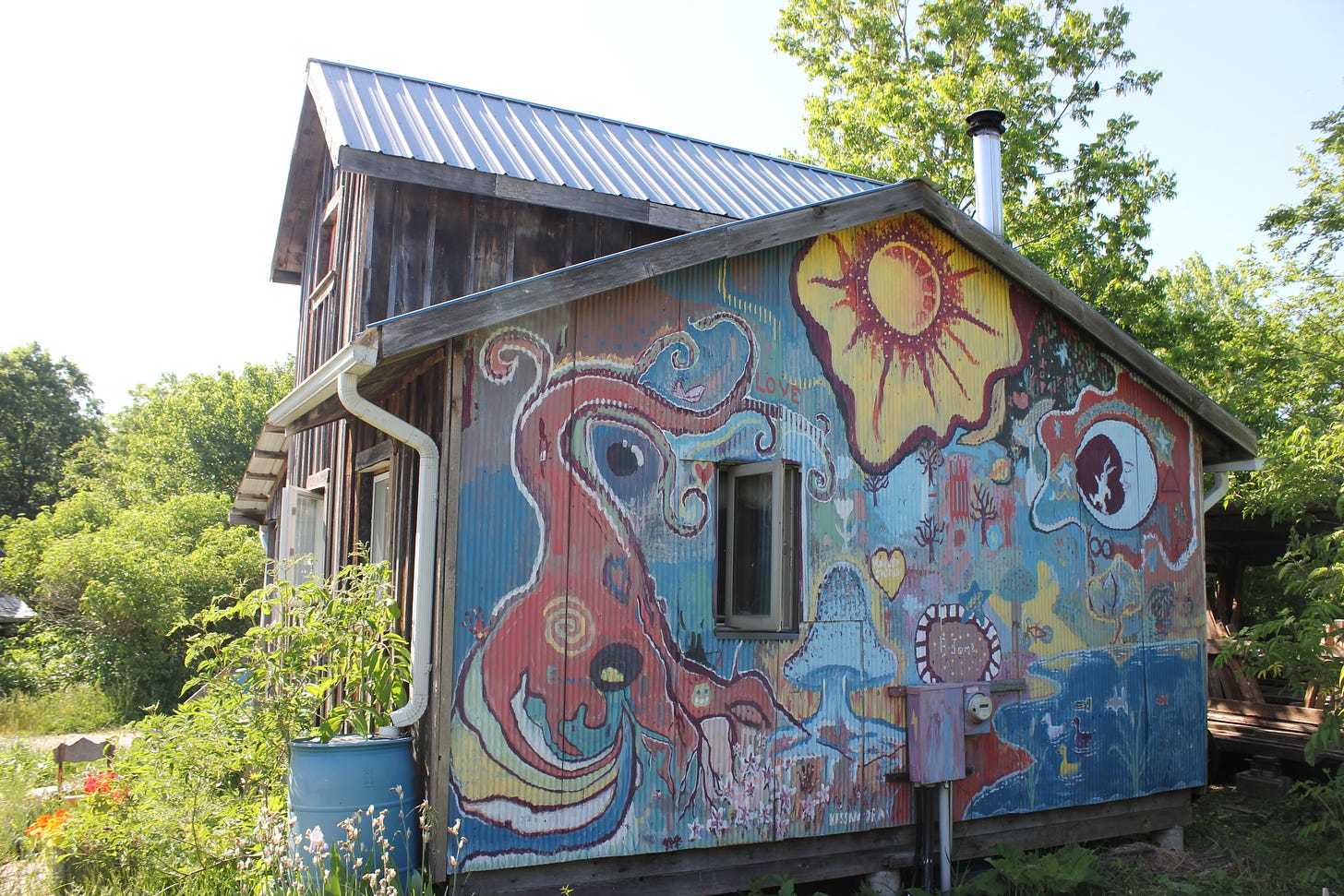Brownie Mix and a Broken Food System
Stories in (Un)Sustainability from Dancing Rabbit Ecovillage
Surrounded by cornfields, cow pastures, and confined animal feeding operations (CAFOs), there’s a small community in Northeast Missouri called Dancing Rabbit Ecovillage. Founded on shared ecological principles of sustainability and resiliency, the Rabbits do things a bit differently than their Midwestern neighbors. I arrive on a hot, dry day in the summer and find homes built out of clay and the community’s timber, complete with cooling systems and solar powered lights. The Rabbits make their own biochar, compost their own human waste, and export energy from their solar panels to the local grid. Compared to industrial agriculture, the Rabbits also farm their food in radically different ways.
Compared to the industrial food system, farmer Ben Brownlow calls Dancing Rabbit the “subverting system.” Ben attempts to maintain a sustainable and resilient food system based on natural processes. Pigs forage in the ground beneath hazelnut and chestnut trees. A herd of goats mows down invasive weeds while chickens rotationally graze a pasture and clear cow manure of parasites. Ducks and turkeys are on pest-control duty; one particularly proud gobbler forgoes his niche and follows me around as Ben shows me the farm. While the turkey vibrates his feathers and bellows deeply, I observe diverse native fauna, and countless species that support a healthy soil.
The fields and forests I overlook were all once barren pastures. Through agroecology—what the United Nations touts as a “holistic and integrated approach” towards “sustainable agriculture and food systems”—they are continually restored. The Rabbits share their labor, and make decisions collectively and by consensus. In controlled prairie burns and town-hall style meetings, the Rabbits work towards food sovereignty and build community sovereignty. Their environmental and social stewardship is only accomplished with “cooperation, sharing, [and] community,” Ben tells me. I later realize that this sort of farming is the future: both a necessity and a hopeful inevitability.
One morning at sunrise, Ben and I meet on a hillside for breakfast. We rest under the shade of a mulberry tree, preparing to move the chickens to a new pasture. The farmer begins a story, prefacing that he’s been seeking to tap into the conventional food system’s waste stream, effectively doing a broken food system a favor by absorbing its waste. He knows that cereal manufacturers concentrated in the Upper Midwest send barges down the Mississippi River. Floating down the big muddy are stale and discolored starches, misprinted processed cake mixes, breakfast cereals with the wrong computerized flavor profile. Ben resolves to make a call and attempt to close a loop. Soon he’s purchasing a one ton shipment of expired brownie mix from a middleman, who tells Ben he usually sells the stuff to nearby CAFOs, which feed it to cows.
A monstrosity of dense, brittle, and high-fructosy carbs arrives at Dancing Rabbit, a pile of stale but sugary junk which honey bees buzz around. Ben chips at the pile of hardened grain with a pickaxe. He looks closely and picks out Lucky Charms marshmallows. Ben tries to feed some of what he describes as “sawdust with some Elmer's glue and marshmallows,” to his animals, just like the standard industry practice. It turns out, though, that brownie mix doesn’t make the most sense as animal feed. The ton of sugary-sweet starch is so divorced from natural systems—so opposite of agroecology—that in Ben’s noble goal to resolve an industrial problem, his own stake at food sovereignty is diminished. “The pigs got fat and didn’t get pregnant that year,” he frowns. “The chickens laid eggs with the palest yolks.” His experiment fails, but what is the lesson?
Brownie mix is the processed, consolidated, sickening reality of the global food system. I drove three hours along fields of Missouri corn and soy—all genetically modified, mechanically planted, and chemically sprayed—to reach Dancing Rabbit. Then, after a few days of working with Ben, he takes me on a field trip around the countryside. We make one right turn in a communally-shared electric car to reach the edge of a cornfield, and step out to look around. The dirt road is dusty; the soil in the field is dry. I bend down to inspect black charred bits of native shrubs and grasses—the graveyard that the herbicide glyphosate leaves in its wake—then stare at green stalks of corn which stand proudly, uniformly at attention. Ben tours me around more, and we reach a CAFO: a set of long windowless white sheds housing thousands of pigs. It smells like shit. The fields were probably sprayed with it recently—hog waste from an open air cesspool called a manure lagoon. A silo automatically dispenses grains—grains like all the others I passed on the highway, like all the others we are currently surrounded by. Large fans in the barn roar, circulating air filled with pollutants. There is no one present except Ben and me. As we peek through a gated window, identical pigs stare back at us. Prophylactically medicated, laden with antibiotics, they are kept alive despite their squalor and suffering. In this moment, they are curious; they watch Ben and I get in the car and head back to Dancing Rabbit. As we drive, the monocultures of corn and soy look never-ending, and the smell of shit lingers in the air despite the car windows being closed. Ben tells me how he strives for something better than the industrial food system, then he sighs: “This work feels meaningless sometimes.”
On the prairies of Dancing Rabbit, Ben is at the forefront of transformative change, but across the world, the global, industrial food system harms everyone. Despite its productivity, the global food system is a source of “widespread degradation of land, water and ecosystems; high [greenhouse gas] emissions; biodiversity losses; persistent hunger and micro-nutrient deficiencies alongside the rapid rise of obesity and diet-related diseases; and livelihood stresses for farmers around the world.” This is all according to the International Panel of Experts on Sustainable Food Systems, which notes that despite the amount of food available, this human right is not close to being fully accessible. The story of Ben’s brownie mix states that this system is not working—that its uniform products are unhealthy, that its manufactured abundance is wasted, and that its complex, starchy processes crystallized by corporate power and government subsidies are illogical. In one slice of just the Midwest, piles of brownie mix are processed in automated factories, sold by corporations fighting for razor-thin profit margins, and sent floating down rivers on barges. Ben says this globalized, industrial food system “seems like a mess.” A system which either ships its inedible junk to landfills or pumps it into the diets of confined cows is indeed quite “unwieldy.”
In the cracks of that glob of brownie mix, there are lunacies and vulnerabilities. Opposite agroecology, the industrial food system is not based upon natural precedents. A system which “leads systematically to negative outcomes” only functions because it is “locked in place by a series of vicious cycles,” says the International Panel of Experts. Confounded, Ben exclaims, “It doesn't make sense that the system is still going.” As it functions, farmers get forced out, CAFOs destroy rural economies, the earth gets warmer, and the inequalities of food grow larger. As the global food system becomes “increasingly dominated and controlled by large multinational agribusiness corporations,” says agricultural economist John Ikerd, small farmers like Ben suffer. “I don’t know who’s making the money,” Ben declares with a slight chuckle and slight sorrow. “The math doesn’t add up.” While government subsidies, cheap labor, corporate influence, chemicals, antibiotics, fossil fuels, and expectations rationalize this senselessness, the globalized, industrial food system will one day fail.
Until that horrifying future, there is an imminent need for change in the present, and much mixed hope. Peter Zeihan, a geopolitical analyst and economist, describes today’s world as “the most distorted moment in human history.” Zeihan calls it “artificial,” and referencing today’s global network of complex, corporate supply chains, he writes that “it doesn't take much…to shatter [such an] interlinked system.” Around the world, the disruptive effects of conflict, population change, and climate change all threaten an incredibly vulnerable food system. “So fragile,” Ben mutters to me as he contemplates… “so fragile.”
Today’s globalized food system is starchy, sugary, and artificial. Left unseen on a road trip to Dancing Rabbit, in the hinterlands of rural Missouri, in the broad face of a pile of brownie mix are realities of soil degradation, global warming, and pollution. Left unheard are the cries of confined animals, sobs of small farmers, and endless stories of unsustainability.
Today’s food system is sticky, fragile, and brittle. Its processed-sugary cracks expose gaps in humanity’s ability to feed and sustain itself. Currently, the world is not fed. As many as 783 million people face chronic hunger, and climate change will further disrupt our ability to feed them.
Today’s food system is flawed. It’s vulnerable to the “catastrophic breakdown” which Ben defeatedly forecasts. And it’s already failing—threatened by a war in Ukraine, a blockage of the Suez canal, and a global pandemic.
A ton of brownie mix and the systems which produce it must compel us towards change. Today’s rapidly deteriorating world demands we farm differently. John Ikerd, an agriculture economist and activist for sustainable food systems, calls agroecology both the “logical alternative to industrial agriculture” and the “logical basis for evolving food systems.” He hopes for a future where “The corporate-controlled industrial/global food system of today would be largely replaced by a community-controlled, sustainable, local food network.” Peter Zeihan, the geopolitical economist, agrees. He hopes that “large-scale, export-driven monocultures will give way to small-scale, local -driven polyculture.” These food systems of the future must embody the social and environmental principles of agroecology to, like Dancing Rabbit, attempt something better than our current one. It’ll require a restructuring of the world’s political and economic hierarchies, systemic policy changes aimed at toppling inequality and unsustainability, and the invaluable work, knowledge, and insight from farmers around the world.
I am hopeful for a world which can embody what Ben cheekily calls a “broad range of kumbaya.” As one Rabbit tells me, Dancing Rabbit Ecovillage is “weird, different, and not perfect.” “Sometimes we feel like we’re failing,” the Rabbit confides in me. I wish I could reassure this community just as much as its efforts towards a sustainable, resilient, and just food system reassure me. There is change to be made, a fight for a better food system to be fought—and communities like Dancing Rabbit are on the front lines. Humanity’s attempt to resolve what might be unresolvable is bound to be imperfect, but we must try our damndest. Our continued survival depends on it.
read more of G.F.’s work here








